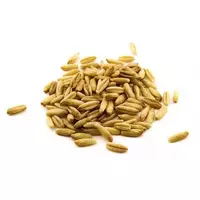Oat grains

Oats sown or common Avéna satíva refers to herbaceous annual plants and is important for the entire human civilization. Oats are rightfully ranked among the oldest cereals that people began to cultivate at the dawn of the development of human civilization. Studies, as well as archaeological excavations, have shown that the homeland of oats is the territory of modern Mongolia, as well as the northern provinces of China.
Although people began to cultivate oats much later than, for example, wheat or cereal barley was quickly appreciated. It is worth emphasizing especially that people at all times appreciated the plant not only for its taste and nutritional characteristics, but also for the beneficial properties of oat grains. It is also noteworthy that initially people used oats as a feed crop and only over time did cereal grains become widely consumed.
The first to appreciate the useful properties of oat grains were the ancient Germanic tribes. The Romans taunted the Germans, who used oat grains to make porridge, as well as baking bread. In ancient Rome and Greece, oat grains were considered suitable exclusively for animal feed. In Russia, oats were also considered an important agricultural crop.
Processing oat grains, people made flour, which was used to bake bread. In addition, useful and highly nutritious porridge was made from oat grains. Oat grains are a unique natural source of vitamins indispensable for the human body, as well as mineral compounds. Oat grains are rich in calcium, magnesium, phosphorus, sulfur, potassium, as well as sodium, selenium, fluorine, zinc, iodine, iron and choline.
In addition, oat grains are enriched with vitamins of group A, B, H, PP, as well as beta-carotene. Oat grains stand out from other cereal crops with a perfectly balanced vitamin-mineral composition. Researchers believe that it is in the chemical composition of oat grains that the balance of carbohydrates, proteins and fats is maintained.
In addition, vitamins and minerals contained in oat grains perfectly complement each other and contribute to the real recovery of the human body. It is also worth noting that oat grains contain vegetable starch, which saturates the human body with energy. Eating oat grains regularly helps control blood sugar levels.
Therefore, oat products are simply indispensable for people who suffer from diabetes mellitus, as well as obesity. Cereals, oats, as well as thin-glass, bran and flour are made from oat grains. Foods produced from oat grains help strengthen human immunity, and are also considered an excellent therapeutic agent for diseases of the nervous system, as well as the gastrointestinal tract.
Oat grains are also used in an unprocessed form as a medicinal product. Infusions and decoctions of oat grains help in the treatment of colds, and also have sweating, antipyretic and diuretic properties.
316 kCal oat grains
Energy value of oat grains (Ratio of proteins, fats, carbohydrates - ju):
Proteins: 10 g (~ 40 kCal)
Fats: 6.2 g (~ 56 kCal)
Carbohydrates: 55.1 g (~ 220 kCal)
Energy ratio (b | y): 13% | 18% | 70%
 Español
Español Français
Français Português
Português Русский
Русский 简体中文
简体中文 繁體中文
繁體中文 日本語
日本語 한국어
한국어 العربية
العربية Türkçe
Türkçe Қазақ
Қазақ Deutsch
Deutsch Italiano
Italiano Українська
Українська
